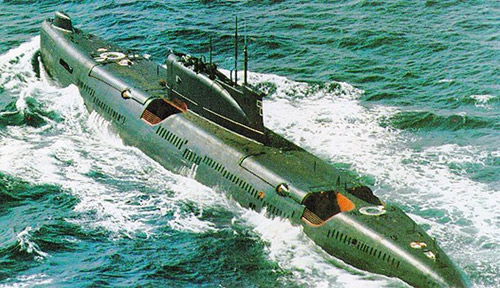Juliett-class
Summary
| Origin country | 🇨🇳 Ex-USSR |
| Category | Submarine |
| Subtype | Air-launch missile submarine |
| Manufacturer | Nizhniy Novgorod |
| Year commissioned | 1963 |
| Units | K-24, K-58, K-63, K-67, K-68, K-70, K-73, K-77, K-78, K-81, K-85, K-120, K-156, K-203, K-304, K-318 |
Description
The Juliett-class submarines, under the NATO reporting name and Soviet designation Project 651, were created in response to the Soviet Navy's need to target American bases and aircraft carriers during the late 1950s. Led by Abram Samuilovich Kassatsier, the design team aimed to equip the Navy with a capability to strike along the U.S. east coast, despite facing limitations with nuclear-powered submarines. As their initial option, the Echo-class submarines, suffered production setbacks due to insufficient nuclear reactors, the Soviet Navy utilized the diesel-electric Juliett-class as an alternative, ordering its production due to fewer resource requirements.
The submarines were outfitted with a nuclear-capable cruise missile system, consisting of four launchers carrying missiles that could be fired while surfaced at low speeds. Initially equipped with the P-5 Shaddock missiles, these were eventually replaced by P-6 for better aircraft carrier targeting. Additionally, one Juliett-class boat received a targeting system upgrade to support the P-500 Bazalt anti-ship cruise missiles. The design of the Juliett-class featured a low magnetic signature double hull, layered with sound-absorbing tiles to reduce noise.
Operational history of these submarines spanned from their commissioning between 1963 and 1968 through the 1980s, with the last being decommissioned in 1994. Although plans originally called for 35 units, only 16 submarines were ultimately constructed. Their operational duration included stints through the Cold War, serving the Soviet Navy’s strategic maritime objectives.
The propulsion and performance of the Juliett-class were powered by diesel-electric systems, which allowed for surface and submerged operation. On the surface, the submarines could reach speeds up to 16 knots and had a cruising range of 18,000 nautical miles. When submerged and operating on electric motors, their range was significantly reduced. They were also fitted with snorkel systems to allow diesel operation underwater.
As for armament, the Juliett-class not only held the aforementioned missile launch systems but also housed torpedo tubes: six in the bow and four in the stern for short-range engagements. Their fire control relied heavily on aircraft for targeting, supporting long-range anti-ship operations with an Argument missile-guidance radar system and other related equipment integrated into the submarine.
The Juliett-class submarines mostly operated for the Soviet Navy, and with the dissolution of the Soviet Union, any remaining active units would have been inherited by successor states. However, their operational use concluded before this transition.
Technical specifications
| Displacement | 3225 tons |
| Displacement submerged | 4203 tons |
| Range | 33000 km at 8 knots |
| Crew | 78 members |
| Width | 9.7 m (31.8 ft) |
| Length | 85.9 m (281.8 ft) |
| Max. depth | 365 m (1197.5 ft) |
| Propulsion | 2 propeller shafts |
| Armament | 4 SS-N-3 Shaddock or SS-N-12 Sandbox + 6 533mm TLTs (18 torpedoes in storage) + 4 400mm TLTs (4 torpedoes in storage) |
| Maximum speed | 16 knots |
| Max. speed submerged | 18 knots |

